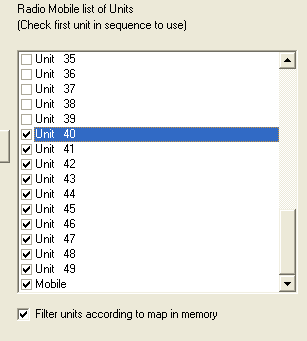|
Opens a form in order to initiate reception from the Automatic Position Reporting System.
This implementation of APRS is for receive only. Radio Mobile cannot broadcast from it's self.
To transmit APRS becons you need to use other APRS software that interfaces with AGWPE.
Radio Mobile is not suitable for beginners in APRS. If you are, please try a mature software such as UI-view!
Before using APRS in combination with Radio Mobile follow these installation steps:
- To use AGW, install properly AGW Packet Engine from AGWPE in order to receive APRS data.
This can be done on the same computer on witch Radio Mobile runs but also on a separate computer that can be accessed over a network connection.
- To use a internet APRS server, use a server with no log-in from: http://www.aprs2.net
- Run Radio Mobile, in "View" select "APRS" and enter parameters requested
For more information look in 'How to' at 'Use APRS'
APRS options

APRS configuration
This part of the window configures APRS in Radio Mobile.
Enable APRS
When checked, Radio Mobile will connect to the configured APRS server or AGW Host.
Record all
If checked all received APRS data will be stored in a 'capture log' The format if this log is described in 'APRS log file format'
Read
Opens a window to open a previous stored APRS log file and replays the log file.
APRS Server or AGW Host
Sets the ip address or server name (which can be reached by DNS) of the APRS Server or AGW Host.
The AGW host can be installed on the same Computer which Radio Mobile runs, Localhost (127.0.0.1) or on any computer that can be reached over the network connection.
Port
The port on which the APRS Server can be contacted. In the case of AGW the default value is 8000
'o-o-o' check box.
Toggles the display of the path over which a station is heard.
APRS Station manipulation
The left table displays the stations heard by Radio Mobile from the start of APRS reception or a 'clear' command.
If a station is selected in this table the last information received from the station is displayed in blue under the table.
The right table displays the current units as configured in 'Units'
The [->] button copies the location and icon information from the mheard list to the position selected in the units list.
'Filter units according to map in memory' checkbox.
Since raw data from non filtered APRS server generates a huge amount of traffic, Radio Mobile had become more or less useless since the number of units is limited and that the internal processing often could not cope with all data to
process.
When checked Radio Mobile sends the following command when you apply the APRS settings:
user nocall pass -1 vers rmw [version] filter r/[lat]/[lon]/[size]
The lat-lon-size parameters corresponds to the map in memory generated by Map Properties.
The larger the map, the heavier the load wild be on the program and on your internet connection.
The filter string is saved in the registry and will not be changed unless you hit the Apply button in APRS options.
You can always edit the APRSserverFilter key manually with regedit before starting the program, assuming that the APRS is already activated. To redefine a new filter, the easy way is to generate an elevation map that corresponds to the area of interest and then hit the Apply button in APRS options.
Apply
Sets als current settings but leaves the APRS options window open.
Cancel
Cancel all changes to the settings and the APRS options window is closed.
Using APRS
Note that you must select a starting station in the station list.
The program will use this station and the following to show APRS. When the end of list is reached, the program will start over at the first station checked. To keep a station permanently, you use the arrow to move it in the lower list. You must click on the station name for the source and destination (do not check!) (all this to overcome the actual 50 stations limitation).

In this example, unit 40 until unit mobile is used for FI-FO rotation of new APRS stations
When receiving an APRS message, the picture is cleared and the stations within the AX.25 header are drawn. A solid circle is drawn around the source station while a dotted circle is drawn around digipeaters. The station by which the message is heard is circled in green while the other are in yellow.
For more information on using APRS with Radio Mobile see 'How to > Using APRS'
|